

by Tony Wrenn, Hon. AIA
Although architects from all parts of the country joined the Institute and there were chapters from New England to the West Coast by 1887, not all architects were comfortable with the New York City-based organization. Midwesterners especially were under-represented in membership and leadership positions within the AIA. Not well known to the Easterners, they were likely to be admitted by AIA trustees as Associate members, though after they had proven themselves, they might be advanced to Fellow.
In 1884, the Midwesterners, at a called meeting in Chicago attended by some 100 architects from 14 Midwestern states, had formed a Western Association of Architects (WAA). Members were elected by the membership, and there was but one category, Fellow. The WAA governing body was a businesslike board of directors, but the WAA was as unrepresentative of architects nationwide as was the AIA. The building boom then under way in Chicago, and the concentration of architects in that city, made it a strong rival to New York, and Chicagoans dominated the WAA as New Yorkers did the AIA. Many architects were members of both the AIA and the WAA and attended both conventions, so each organization was aware of the aims and activities of the other.
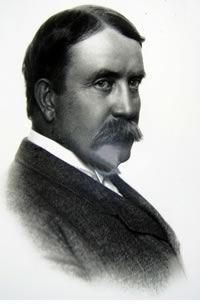 Towards
“One AIA”
Towards
“One AIA”
At the 1887 AIA convention, the 21st for the Institute,
founder Richard Morris Hunt was elected the third AIA president,
and Chicagoan and WAA member Daniel H. Burnham, who had been an AIA
member since 1884, presented “Suggestions Toward the Best and
Speediest Methods for Harmonizing and Utilizing all the
Architectural Societies in the United States,” zeroing in on
the AIA and WAA. Burnham suggested appointment of an AIA committee
“to act with another from the Western Association. These two
should be empowered to meet, and prepare a plan and recommendations
to be submitted for the consideration of both bodies in 1888 ... I
do not know,” Burnham said in suggesting consolidation, that
“there is today a single society or name to be kept, unless
perhaps it be the title ‘American Institute of
Architects,’ and this only because its dicta are the basis of
so many court decisions in every State, and because its name and
reputation are incorporated in the records of many foreign
societies. This question, however, is for some future committee to
deal with. The matter of naming is of little consequence compared
to what the constitution and by-laws shall be,” and he warned,
“If the name of the American Institute or any other society be
retained, it must not mean that their organization shall be kept as
it is today; it must be radically different.”
Even with talk of a merger and appointment of the suggested committee, AIA Trustees still seemed unable to accept the WAA as its equal. When, in January 1888, the secretary of the WAA twice wrote the AIA “inviting correspondence & enclosing a list of officers...,” the AIA secretary replied with “an invitation to the Association to apply for admission as a chapter” of the AIA. Still, in 1888, members of both organizations voted to consolidate.
Towards inclusion
That year, 1888, a woman, Louise B. Bethune of Buffalo,
applied for AIA membership, something the WAA had already granted
her. She applied for a Fellowship, and AIA Secretary A. J. Bloor
suggested that she “apply first for Associateship &
forward to him specimens of her own professional work.” Bloor
asked for “a few drawings & a specification of your firm,
as well as some slight credential of your individual work, say an
elevation & a plan, whether finished or sketchy makes little
difference, as long as the design [sic] is your own.
“Don’t,” he continued, “trouble yourself about
another endorser. I will ask one of my fellow Trustees to be
sponsor with me.”
 She reapplied,
sending specifications for “P. Hoffman’s Millinery
House,” along with blueprints of it and of Buffalo
“Police Station No. 2”, Buffalo “School No. 4,”
and four residences, and a “set of tracings and one pen and
ink drawing” of a fifth residence. Trustee Minutes for April
4, 1888, note the application, from “Mrs. Louise Bethune, of
Buffalo, N.Y. dated March 12th 1888, a practitioner for 12 years,
proposed by Mr. G. W. Rapp & the Sec’y [Bloor]. Also
communications recommending her for membership from Mr. Sidney
Smith of Omaha, Neb, Pres’t W.A.A. of March 15th 1888 &
from Mr. G. W. Rapp, of Cincinnati, of March 23rd 1888,
recommending her for Fellowship. Also specifications & blue
prints of executed work from drawings of her personal
execution.” The minutes note that “after some discussion
Mrs. Bethune was elected an Associate.”
She reapplied,
sending specifications for “P. Hoffman’s Millinery
House,” along with blueprints of it and of Buffalo
“Police Station No. 2”, Buffalo “School No. 4,”
and four residences, and a “set of tracings and one pen and
ink drawing” of a fifth residence. Trustee Minutes for April
4, 1888, note the application, from “Mrs. Louise Bethune, of
Buffalo, N.Y. dated March 12th 1888, a practitioner for 12 years,
proposed by Mr. G. W. Rapp & the Sec’y [Bloor]. Also
communications recommending her for membership from Mr. Sidney
Smith of Omaha, Neb, Pres’t W.A.A. of March 15th 1888 &
from Mr. G. W. Rapp, of Cincinnati, of March 23rd 1888,
recommending her for Fellowship. Also specifications & blue
prints of executed work from drawings of her personal
execution.” The minutes note that “after some discussion
Mrs. Bethune was elected an Associate.”
Titles indicating gender had never before been necessary in the minutes for all previous applicants and endorsers had been men. Though the AIA “discussion” is not reported, Inland Architect and Builder (IAB) did report, in 1885, on her election to the WAA. Names of prospective members had been read to Convention attendees, and, on motion, all “prospective gentlemen” were voted in. That motion clearly did not admit Bethune, also an applicant, and the general question of women as members and of Bethune as the first woman member was later discussed. It is said that in the discussion a WAA member noted that “the question is not whether the architect is a lady, but whether the lady is an architect.” IAB reported that one member said “If the lady is practicing architecture and is in good standing, there is no reason why she should not be one of us,” and she was admitted to the WAA. In spite of the fact that gender barriers to membership were dropped in 1888, even today women in the profession are under-represented among AIA members.
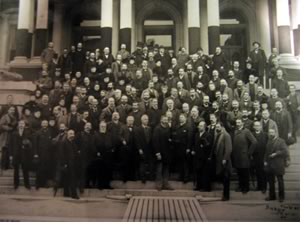 Growth
and consolidation
Growth
and consolidation
In 1889, the WAA and the AIA, intent on marriage, both met in
Cincinnati. After a series of legal maneuvers, during which the WAA
voted itself out of existence, WAA and AIA members met jointly and
voted for a new AIA constitution and by-laws which, since both
memberships voted for it, recognized all as members of the AIA. The
new constitution retained the AIA name, the founding date of 1857,
and incorporation in New York, but there were changes.
“Trustees,” which hinted of a church or college
relationship, became business friendly “directors,” and a
single member category, “Fellow,” was established.
Accordingly, all previous WAA members continued membership as
Fellows, and all then-current AIA members became Fellows. It was
another 10 years, 1898, before the constitution was modified to
reestablish two classes of membership. Members would, in the
future, be elected to membership and might later be advanced to
Fellowship.
An 1892 report to the Board noted: “4 new chapters have been organized; seven new charters have been granted; eleven fellows have been admitted to membership; one fellow has resigned; five fellows have died; showing a net increase of six fellows and making the member of the Institute at the present data as follows: Number of Chapters, 26; Number of Fellows, 475; Number of Honorary Members [non architects] 81; Number of Corresponding members [foreign architects], 67.” In its fourth decade, AIA membership climbed above 400. Still, Dankmar Adler mused, “When cross-examined we are compelled to admit that the membership of the Institute as probably less than 1/6, perhaps less than 1/8, perhaps less than even 1/10 of the members of our profession in the country.”
 The fairest of
the fair
The fairest of
the fair
Whatever the percentage of architects represented in AIA
membership, the AIA was, after 1889, the single national body
representing American architects. With that position secure, it
could turn its attention to the international scene, and did so
with the 1892-93 World Columbian Exposition to celebrate the 400th
Anniversary of Columbus’ voyage to America. Chicago had won
the right to host the exposition, and architects aimed to insure
the celebration surpassed all previous world fairs. With AIA
members D. H. Burnham as chief of construction; John W. Root as
consulting architect; Richard Morris Hunt, McKim, Mead and White,
and George Brown Post of New York, Peabody & Stearns of Boston,
Van Brunt & Howe of Kansas City, and Adler & Sullivan, and
W. L. B. Jenney of Chicago as architects; and soon to be Honorary
Member F. L. Olmsted as landscape architect, design and planning
was firmly under the control of AIA-member architects. As Mary
Woods writes in her work From
Craft to Profession, “The exposition buildings,
designed on a monumental scale and integrated into a master plan,
demonstrated what professional architects could
accomplish.”
Indeed, the World’s Columbian Exposition changed the manner in which the public viewed architecture, landscape architecture, city planning, and related arts, ushering in the City Beautiful movement, which would sweep America and be noted abroad. Dankmar Adler, who had witnessed work at the fair from its beginning, told the October 1892 AIA Convention in Chicago that, “Probably there is not one among you who saw these grounds but eighteen months ago who would have thought at that time that it would be practicable to accomplish one-half of what has been done ... I did not believe it possible, that this work could be accomplished on the scale of magnitude and quality upon which it has been done, and in the time.”
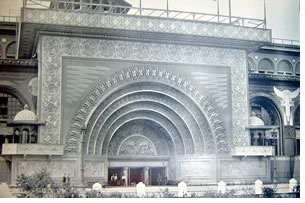 Adler
continued, “I think it is something upon which we all should
look with pride, to know that we have among us artists who have
designed these great buildings ... For this prominent example will
be followed again and again, and the authorities who have in their
charge public works will have to fall back upon it as a precedent,
and can no longer place the architect upon the plane of a mere
employee not worthy of recognition for the work he has done because
he is paid for it. The fact is that upon this occasion, architects,
sculptors, painters, engineers, all who have assisted in the great
work, receive public recognition, and receive a recognition before
all the world such as has never before in America been awarded them
for work performed, in a manner that is bound to be followed by the
managers of other public enterprises.”
Adler
continued, “I think it is something upon which we all should
look with pride, to know that we have among us artists who have
designed these great buildings ... For this prominent example will
be followed again and again, and the authorities who have in their
charge public works will have to fall back upon it as a precedent,
and can no longer place the architect upon the plane of a mere
employee not worthy of recognition for the work he has done because
he is paid for it. The fact is that upon this occasion, architects,
sculptors, painters, engineers, all who have assisted in the great
work, receive public recognition, and receive a recognition before
all the world such as has never before in America been awarded them
for work performed, in a manner that is bound to be followed by the
managers of other public enterprises.”
Indeed, the great White City of monumental buildings, all painted white, viewed amid masses of landscape green and the blue of created lagoons with Lake Michigan itself beyond, lived up to expectations. It opened on May 1, 1893, answering Eiffel’s tower at the 1889 Exposition Universelle in Paris, with engineer George Ferris’ massive wheel. On October 9, 1893, 751,026 persons attended, “more people than had attended any single day of any peaceable event in history,” according to Erik Larson, in The Devil in the White City. Larson continues: “The fair taught men and women steeped only in the necessary to see that cities did not have to be dark, soiled, and unsafe bastions of the strictly pragmatic. They could be beautiful.”
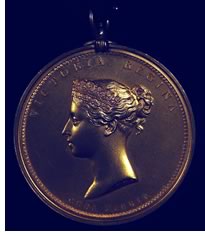 The
Chicago fair was such an international success that MacVickar
Anderson, president of the Royal Institute of British Architects
(RIBA), would, as reported in American Architect and Building
News in 1893, label it “the most wondrous development
that international exhibitions have ever reached, or perhaps, are
ever likely to attain.”
The
Chicago fair was such an international success that MacVickar
Anderson, president of the Royal Institute of British Architects
(RIBA), would, as reported in American Architect and Building
News in 1893, label it “the most wondrous development
that international exhibitions have ever reached, or perhaps, are
ever likely to attain.”
International recognition
The fair played no small part in insuring the award to
Richard Morris Hunt of the RIBA Gold Medal, presented in London on
July 15, 1893. Anderson spoke of the Gold Medal as “the gift
of her most gracious majesty, Queen Victoria,” and continued
“The fact that you [Hunt] have traveled some thousands of
miles in order that you might personally receive this medal may be
accepted as sufficient evidence of the high estimation in which you
rightly regard the honor.
“It is indeed, the highest which we are graciously permitted to offer to the most illustrious architects of the world, and we indulge the hope that our American brethren will recognize in this royal gift which we are privileged to present to their most eminent representative, the embodiment of the hearty good will, the sincere respect, and the ardent admiration with which they are regarded by the architects of the Old World.”
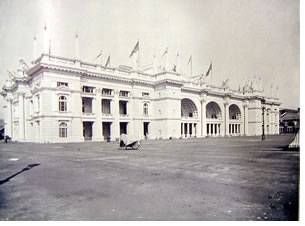 Hunt
responded “I accept it, and am proud of it, proud of it for my
country, for, in accepting it, I accept it not altogether as a
personal distinction or a personal honor, but as an honor conferred
upon the whole profession in the United States, in which light it
is so regarded ‘on the other side.’”
Hunt
responded “I accept it, and am proud of it, proud of it for my
country, for, in accepting it, I accept it not altogether as a
personal distinction or a personal honor, but as an honor conferred
upon the whole profession in the United States, in which light it
is so regarded ‘on the other side.’”
Meanwhile, at the end of July 1893, at its 27th Convention in Chicago at the World’s Columbian Exposition, the AIA hosted a “World’s Congress of Architects.” Formally opened on July 31, it ran for five days. At the first session, Daniel Burnham spoke on the history and organization of the fair, stressing architecture and construction, and F. L. Olmsted presented a paper on the general scheme and plan of the fair. These were followed by papers on transportation, electricity, and power at the exposition. Architects from Japan, France, and England and other Americans made formal presentations and discussed papers presented. The AIA printed the proceedings of the World’s Congress as a supplement to the AIA Convention proceedings, thus projecting the AIA onto the international scene and buttressing the international renown already earned by architects of the World’s Columbian Exposition and RIBA’s award of the Gold Medal to Hunt, the first such international recognition of an American architect.
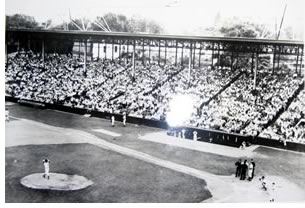 A
home in the nation’s capital?
A
home in the nation’s capital?
Earlier, in 1882, Glenn Brown, a Washington, D.C.,
architect, had joined the AIA and notified the Institute that he
intended the formation of a Washington Chapter. In 1887 he was
advanced to Fellow, and that year the AIA heard, at Convention, the
report of a “Special Committee on a Permanent Home for the
Institute.” The committee reported: “That in their
judgment the permanent home of the Institute should be a fire-proof
building in the business part of the City of New York.” At
that same Convention, the Washington Chapter, organized on May 26,
1887, made its first report. It had very different plans for the
AIA. Washington, the chapter felt, was the logical home for the
Institute and, in 1896, it formally petitioned the Board to appoint
a committee to consider a move to Washington, which, “as the
seat of the Government is the proper place for the headquarters of
all National Associations.”
The fourth decade would end with the move being considered. The fifth decade would begin with its being decided, a decision which insured an extended Golden Age for the Institute, for architects, and for Washington, D.C. Begun with the formation of the Washington Chapter in 1887 and, brightened by the international success of the World’s Columbian Exposition in Chicago in 1892-93, the AIA’s Golden Age would run for some 30 years.
Copyright 2005 The American Institute of Architects. All rights reserved. Home Page

